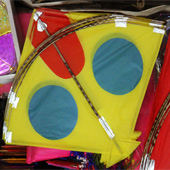Design Resource
Kite Making - Gujarat
Paper Kites for Uttarrayan Festival
by
Prof. Bibhudutta Baral, Divyadarshan C. S., Abhishek G. and Lija M. G.
Wooden Firkhi Making:
Firkhi is cylindrical shape roll, which is attached with handles on either side of the end to hold it. The kite thread is rolled on this firkhi. The firkhi is either made of wood or of plastic. The wooden firkhi’s are made of three types’ of wood:
• Mango tree wood,
• Neem tree wood and
• Babul tree wood.
These woods are purchased from nearby villages. The parts of the firkhi are made separately and joined. The side caps of the firkhi and the handle is made of wood, whereas the middle roll where the kite thread is spun is made up of cardboard rolls.
The wood is cut into required shape with a cutting machine. The caps are shaped in disc form. The wooden discs are attached to the turning machine to smoothen the disc surface using sandpaper. After the parts of the firkhi are made, they are checked for cracks, if found the cracks are filled with the mixture of sand husk, adhesive and wood shade color powder. Company’s name is screen printed on the wooden discs. Cardboard roll edges are dipped in adhesive and fixed to the wooden discs.
Coat of vibrant color paint is applied on the firkhi handle to make them look attractive. Wooden firkhi’s are made only on demand, as they are expensive compare to plastic ones, which are extremely used.
Plastic Firkhi Making:
Plastic firkhi is used abundantly than wooden firkhi as they take less time to prepare and the material is available easily. Parts of the plastic firkhi are manufactured in industries. Local Shopkeepers buy these parts in bulk order and assemble the parts in their factories or houses. Side caps of the firkhi are pierced to attach the handle. The caps are fixed to the cylindrical body by hammering nails into it. Later the handles are inserted and nailed to fix firmly. The assembled plastic firkhi are sold in the market. People prefer plastic firkhi as it is light in wait compared to the wood ones. These plastic firkhi are available in different colors and sizes rolled in colorful kite threads.

















